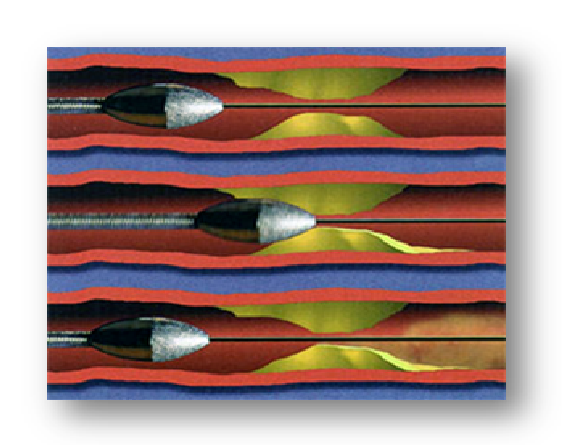A rotablator, which was first introduced in 1993, is a miniature drill capped with an abrasive, diamond-studded burr. The rotablator is used in a type of catheter-based procedure called rotational atherectomy.
Rotational atherectomy is a minimally invasive treatment that is sometimes used to pulverize hardened plaque within a coronary artery. During rotational atherectomy, the rotablator is guided to the blockage via a catheter – a thin, flexible, hollow plastic tube small enough to be threaded through a blood vessel.
Rotablator Procedure (RP)
Your doctor may feel the particular plaque formation closing off one of your arteries can be managed better using a rotablator procedure (RP). This procedure is used when:
• The plaque is felt to be too difficult to flatten against the artery wall with just a PCTA.
• The plaque appears to have a large amount of calcium present in it and won’t move easily.
• The plaque is too long or starts where the artery begins.
• The artery has too much plaque, which needs to be removed before doing another procedure.
• The artery is felt to be too small for other procedures.
• A PCTA and/or stent has been done before and the lesion has reclosed.
Rotational atherectomy is a minimally invasive treatment that is sometimes used to pulverize hardened plaque within a coronary artery. During rotational atherectomy, the rotablator is guided to the blockage via a catheter – a thin, flexible, hollow plastic tube small enough to be threaded through a blood vessel.
Rotablator Procedure (RP)
Your doctor may feel the particular plaque formation closing off one of your arteries can be managed better using a rotablator procedure (RP). This procedure is used when:
• The plaque is felt to be too difficult to flatten against the artery wall with just a PCTA.
• The plaque appears to have a large amount of calcium present in it and won’t move easily.
• The plaque is too long or starts where the artery begins.
• The artery has too much plaque, which needs to be removed before doing another procedure.
• The artery is felt to be too small for other procedures.
• A PCTA and/or stent has been done before and the lesion has reclosed.

During this procedure a very small device called a rotablator is used. It is the shape of a tiny football and comes in many sizes to suit various arteries. It is threaded over a guidewire through the catheter that is used to inject dye at the blockage site.
The tip of the rotablator is coated with very tiny pieces of diamond crystals. Air pressure (turbine) is used to power and rotate the tip at very high speeds against the plaque. When the tip is rotated, it sounds much like the tools a dentist might use. Short bursts of power will be used to rotate the tip up to 190,000 rpm. This will grind or break the plaque down into very small particles. These particles are the size of sand dust which are smaller than a red blood cell. The dust is flushed downstream in the blood with IV fluids to be cleaned up and removed by the body’s natural defenses.
The diamond cystal tip will only grind the plaque because it is firmer and more rigid than the soft flexible tissue of the artery itself. This is much like shaving brittle hair off of soft skin.
You may experience some angina during the procedure because the artery is blocked. Be sure to let your doctor know if this occurs. It is common to feel a little sore or bruised inside your chest after an RP. This will go away in a day or two.
The rest of your hospital stay after an RP is usually one night and is much like recovering from a regular cardiac catheterization.
The tip of the rotablator is coated with very tiny pieces of diamond crystals. Air pressure (turbine) is used to power and rotate the tip at very high speeds against the plaque. When the tip is rotated, it sounds much like the tools a dentist might use. Short bursts of power will be used to rotate the tip up to 190,000 rpm. This will grind or break the plaque down into very small particles. These particles are the size of sand dust which are smaller than a red blood cell. The dust is flushed downstream in the blood with IV fluids to be cleaned up and removed by the body’s natural defenses.
The diamond cystal tip will only grind the plaque because it is firmer and more rigid than the soft flexible tissue of the artery itself. This is much like shaving brittle hair off of soft skin.
You may experience some angina during the procedure because the artery is blocked. Be sure to let your doctor know if this occurs. It is common to feel a little sore or bruised inside your chest after an RP. This will go away in a day or two.
The rest of your hospital stay after an RP is usually one night and is much like recovering from a regular cardiac catheterization.
Cardiac Specialty Care
• Structural Heart Disease
• TAVR
• CardioMEMS (Heart Failure)
• PFO Closure
• TAVR
• CardioMEMS (Heart Failure)
• PFO Closure
• Coronary Intervention
• Complex Higher-Risk (And Indicated) Patients (CHIP) Angioplasty
• Atherectomy
• Impella and ECMO Support
• Complex Higher-Risk (And Indicated) Patients (CHIP) Angioplasty
• Atherectomy
• Impella and ECMO Support
• Peripheral Angioplasty
• Varicose Vein Treatment (Venous Ablation)
• DVT thrombectomy - IVC filter
• Carotid Stenting
• Varicose Vein Treatment (Venous Ablation)
• DVT thrombectomy - IVC filter
• Carotid Stenting
• Rhythm Management
• Pacemaker
• Holter Monitoring
• Exercise Stress Test
• Echocardiography
• Nuclear Stress Test
• Enhanced External Counterpulsation (EECP)
• Pacemaker
• Holter Monitoring
• Exercise Stress Test
• Echocardiography
• Nuclear Stress Test
• Enhanced External Counterpulsation (EECP)
